

Designation:MBR-13A, B, C Salamander
|
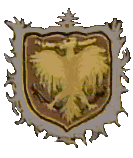
|
||||
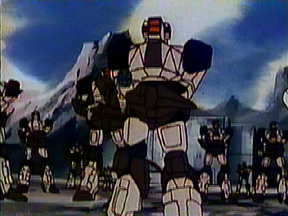
|
|||||
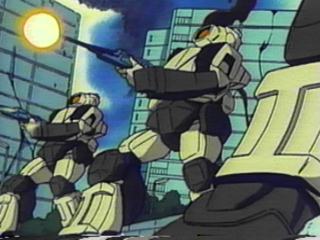
| MBR-13 | MBR(S)-13 | |
|---|---|---|
| Total Height: | 6.1 m | 6.1 m |
| Total Depth: | 2.4 m | 2.5 m |
| Total Breadth: | 2.8 m | 2.9 m |
| Weight: | 14.0 metric tons | 14.6 metric tons |
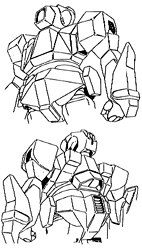
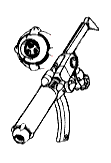
Common optional hand-held gun pods:
|

|
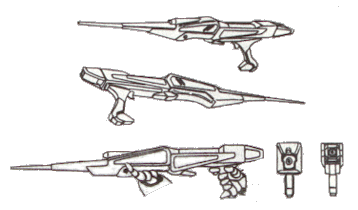
|

|
The armor on the Salamander is a new development in low-mass composite-materials Chobham plating that became the standard for all Terran mecha after its application to the VQ-6A Vandal. Aside from the respectable protection provided against projectiles, missiles, and other kinetic weapons, this armor is also resistant to plasma globes (annihilation discs), lasers, and to a lesser extent, particle guns, owing to the fact that the armor can flake off and evaporate in layers under fire from such high-energy weapons, taking much of the weapon's energy and converting it into the latent heat of sublimation in the armor. The armor stops all small arms, heavy infantry weapons fire, and light mecha-mounted weaponry, and provides fair to good resistance to medium mecha-mounted weaponry, such as the Valkyrie's 55mm APFSDS round. The arm shields have additional armor providing good resistance to medium mecha-mounted weaponry and poor resistance to heavy mecha-mounted weaponry, such as the VHT-2's 120mm shell. The shins and joints are reinforced to withstand impact from a moving vehicle.
The Salamander provides full protection from nuclear, biological, and chemical hazards, using a fully sealed cockpit module activated by radiation and hazardous chemical sensors, or manually when biological warfare conditions are anticipated. The module is also armored and gives the Salamander the option of operating off-planet on the moon or elsewhere in the system. The internal consumables supplies can provide atmosphere purification for one week maximum on Earth and 48 hours in a hostile environment such as the moon or Mars. The MBR(S) models double the consumables supply to last for 96 hours in a hostile environment.
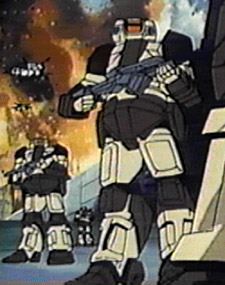
By the late teen's, the Southern Cross was operating an odd mix of conventional armor and a few over a decade old destroid designs. They expected the destroids to reach the end of their service life by the mid twenties, and they would need replacement. Those destroids which had low service hours were going to be refit and taken with the departing Pioneer mission. Also, the Southern Cross Surface Command decided that the larger destroids were too conspicuous and vulnerable to standoff missile attacks to be fully effective. A smaller destroid would have better survivability since it would be harder to see and hit as well as being more agile due to the reduced mass. This smaller and more agile mecha could also better adapt to a variety of operating environments.
From this situation, the battloid concept evolved: a smaller, more agile, multi-purpose robot. To decrease the size and provide operational flexibility, the primary weapons shifted to an assortment of gunpods instead of the slow to reload integral weapons. Most importantly the smaller battloids were much simpler and cheaper to manufacture than the new REF destroids, allowing the depleted Southern Cross armies to rapidly rebuild a cohesive fighting force after being depleted by the departure of the Pioneer mission and their assignment of most of Earth's mecha forces.
The Salamander was the first ASC battloid designed purely for combat and patrol activities. The Southern Cross development group took lessons learned from the Dryad and Satyros designs as well as historical information from the early RDF destroids to develop the Salamander. The Salamander was viewed as a downscaled version of the Spartan mecha. It was a high mobility mecha, with prehensile hands. To further keep costs down, the cockpit suite was designed to be modular so that only a subset of the mecha had the extensive C3I gear needed to command larger units. The basic unit had a cockpit suite sufficient to maintain battlefield awareness of its immediate surrounding, without the need to coordinate between numerous units. Officers received the complete electronics suite, and non-commissioned officers received a slightly reduced-functionality version due to the smaller units involved. When operating as a unit, the Salamanders and other mecha would share battlefield information, so that each mecha would have a complete picture of their environment.
Another big cost saving came from the fact that unlike the large, older destroids or the newer REF destroids, the basic Salamander did not need to be space-capable. The large, older destroids had a full thruster/venier suite to allow them to operate in space, as they did from the decks of the SDF-1 during the first Robotech War. The ASC decided it would be more cost effective to simply put more AAA batteries on their capital ships and keep the battloids on the ground. The Salamander could operate on the moon and on Mars thanks to a sealed cockpit module, but it was devoid of all the expensive systems seen on the Destroids which made them truly SPACE capable. All in all, the ASC saved 25% per unit, and were thus able to field more units.
The Salamander has three different modular head styles for enlisted, non-commissioned officers, and officers. Models could be interchanged in just a few hours by swapping head units and cockpit avionics units. NCO and officer models (B, and C) have a heavier and more expensive E-5 head laser system for improved performance. Costs prohibited widespread dissemination of the system and as such was restricted to more senior personnel. The B-model has an improved array for the radar as well as an upgraded combat suite. The C-model carries a more sophisticated communications, sensor and control suite to assist in monitoring the battlefield situation. This is readily identifiable by the 'V' angled dual array in the head of the C-model compared to the flat, square array of the B-model and flat, circular array of the A-model.
A specialized version was built for the TC-Lunar Division, called the MBR(S)-13. It was little more than a standard Salamander with enhanced environmental systems optimized for a vacuum environment, as well as additional vernier thrusters for maneuverability. Its thruster and venier system allowed it to operate in free fall, much the same way that the older and larger destroids could. This system allowed it to make short flights when operating in the Moon's weak gravity field for increased mobility. If long duration operations or free space operations were needed, a strap-on pack system was designed for enhanced vernier operation and to extend the fuel supply to a reasonable level for zero-gravity operations.
Of the SC battloids, the Salamander was the most widespread in use. Designed by Bofors, they were also produced by Teledyne Continental and Vickers. A variety of gunpods were used throughout its service life. The GU-13 was the model used when the Salamander was introduced, but eventually replaced with the more durable and less logistically demanding energy weapons. The EU-10 and EU-11 were preferred when penetration was important. The EU-22 was used when damage potential was more important.
Many Salamanders were destroyed by the Tirolian Bioroids, and Roil series attack craft during the 2nd Robotech War. The remains of the Southern Cross command attempted to replenish their depleted ranks of Salamanders after the destruction of the Robotech Master fleet. While they succeeded in mass producing the Salamander, they lacked sufficient surviving combat veterans to train the masses of new recruits due to the high casualty rate versus the Robotech Masters' forces. Unfortunately, while the agility of the Salamander proved effective against the Invid one-for-one, the masses of Iigaa and Gurab, exacerbated by the combat inexperience of the average trooper, just overwhelmed the Tactical Corps battloid battalions, and destroyed a majority of the remaining Salamanders.
Go to Southern Cross Battloid Gallery.
See additional design notes.
Return to Southern Cross Mecha Index.
Go to Robotech Reference Guide Home Page.
Robotech (R) is the property of Harmony Gold. This document is in no way intended to infringe upon their rights.
Content by Rob Morgenstern and Tim Wing, with Pieter Thomassen